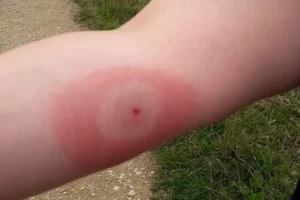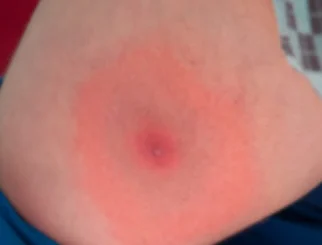Early vs Late Lyme Disease: Spotting the Differences Before It’s Too Late
Lyme disease presents itself differently depending on how it progresses. Stages are labeled as localized, disseminated, or persistent, depending on how fast you get treatment. Significant delays in treatment frequently lead to long-term damage, even after Lyme disease is technically treated.
It’s important to treat Lyme disease before it reaches its disseminated stage. This helps you advocate for yourself and receive timely treatment, with no lasting damage.
This article will present the stages of a Lyme infection and its atypical forms so that you may prevent its progression.
Recognizing Early Lyme (Localized Stage)
Early signs of Lyme are a mixture of localized skin issues with flu-like symptoms. Most patients recognize a Lyme infection from the appearance of a bullseye rash. Other patients experience only symptoms such as fever or muscle pain. This causes them to mistake the condition for the common flu.
Classic vs. Non‑Classic Rashes
The classic rash that patients get after being bitten by a tick is called a “bullseye rash.” This rash looks exactly like its namesake: a bullseye, or a target.
The rash is medically referred to as an erythema migrans. It has a circular red area at the bite point, followed by a central clearing (a paler ring), and then a reddish ring on the outside. Data from the CDC suggests that an average of 70-80% of patients get a bullseye rash.
Still, that also means that 20-30% of people DON’T get a bullseye rash. In atypical scenarios, if the rash does appear, it can look as follows:
- A solid red patch in the bite area
- A well-defined ring without the central clearing
- A lesion that looks like a bruise
- Multiple smaller rashes in the target area
Rashes vary in form, causing them to be frequently misdiagnosed. They are dismissed as allergic reactions, spider bites, or simple skin irritation. This causes patients to miss the initial window for treating Lyme and risk PTLDS.
It is possible to get Lyme disease even without the rash, which makes diagnosis even more complicated. Its absence doesn’t rule out the disease but suggests a “glitch” in the immune response. If you are aware of a recent tick bite and get an atypical rash, keep track of your symptoms.
Flu‑Like Symptoms and Early Signs
Early localized Lyme often skips the rash and immediately goes into flu-like symptoms. Studies by John N. Aucott at Johns Hopkins Greenspring Station, Lutherville, show that 27% summer “flu” patients had evidence of a tick-borne infection.
Lyme infections also hiked up by 300%. This makes it more difficult to differentiate them from the flu without knowledge of the tick bite.
Common flu-like symptoms frequently experienced by patients include:
- Headaches
- Chronic fatigue
- Low-grade fever
- Sweats
- Muscle aches
- Joint pain
- Stiff neck
- Swollen lymph nodes
- Malaise
The disease is frequently called “The Great Imitator” because the symptoms mimic so many conditions. This symptom overlap is many times the reason why people miss the “treatment window” for Lyme disease.
Symptoms occur within 3 to 30 days after the tick bite, depending on the immune reaction. The patients mistake them for a regular cold or summer flu, causing the actual disease to go unnoticed.
Patients should take action after a tick bite to prevent disease dissemination. It’s important to check for ticks each time you go into tall grass or risk areas. If you get bitten and develop symptoms, track and document them. Seek prophylactic treatment to prevent it from spreading any further.
When Lyme Spreads: Disseminated and Late Stages

Lyme disease that is not caught early becomes disseminated. It spreads to other parts of the body and develops different symptom types. Their severity depends on the timeline, with late dissemination stages having the worst symptoms.
Early Disseminated Lyme — Weeks Later
Early disseminated Lyme occurs as Borrelia burgdorferi spreads through the bloodstream. When this happens, patients develop symptoms such as:
- Multiple rashes (not necessarily bullseye)
- Facial palsy that frequently gets mistaken for Bell’s palsy
- Neurological symptoms such as shooting pain in the muscles
- Meningitis-like symptoms, such as neck stiffness
- Heart issues such as rhythm changes, Lyme carditis, or even heart block
When Lyme disease reaches this stage, it indicates a systemic spread of the infection. Most patients require hospitalization at this point because the symptoms escalate quickly.
Lyme is capable of affecting the nervous system, leading to a condition called neuroborreliosis. This affects your peripheral or central nervous systems. Symptoms differ based on the affected brain structure but include muscle weakness, cognitive dysfunction, and sleep disruptions.
Late Disseminated Lyme — Months to Years Later
Disseminated Lyme that is not properly treated can turn years later into chronic Lyme. At this point, Lyme doesn’t just enter other systems of the body but significantly affects them as well.
In this case, Borrelia burgdorferi causes significant inflammation in the joints and other parts of your system. The symptoms persist for months, perhaps even years, after the tick bite.
The symptoms persist or worsen despite treatment, leading to a condition called PTLDS (post-treatment Lyme disease syndrome).
Statistics from the Bay Area Lyme Foundation show that about 20-34% patients get these symptoms post-treatment and struggle with them for years.
Some of the most common late disseminated Lyme symptoms include:
- Lyme Arthritis: This occurs especially in your knee joints, which become painful, swollen, and stiff.
- Persistent Fatigue: This doesn’t get better even after you get enough rest.
- Neurological Symptoms: Include neuropathy signs such as tingling, numbness, random sharp pain, and even coordination issues. Migraines, tinnitus and visual issues can also be present.
- Cognitive Issues: Memory loss, brain fog, and difficulty recalling words.
Organizations such as ILADS believe that these lingering symptoms are a sign of a persistent bacterial infection. An average of 10-30% patients experience late-stage Lyme symptoms despite undergoing antibiotic treatment.
Complications occur after Borrelia burgdorferi embeds itself in the tissue. Left unresolved, it triggers low-level immune responses for years. It’s essential to track your chronic Lyme symptoms and understand their cause so that you get the appropriate treatment.
Why the Staging Model Isn’t Always Reliable
The staging model is not always reliable because patients can experience the symptoms in a different order. Disseminated symptoms appear first, whereas the “early” ones appear as Lyme progresses. Understanding atypical cases is important to prevent a misdiagnosis.
Overlapping and Atypical Progression
Lyme stages overlap and have atypical progression, depending on the circumstances. In other cases, neuroborreliosis appears before the rash does. Other times, patients skip a stage altogether and go straight to the chronic phase.
For example, a patient may experience brain fog a few weeks after the tick bite, with no rash or flu-like symptoms beforehand. In other cases, muscle numbness and shooting pain happen fast, within days after the tick bite. Some get late-stage symptoms a few weeks after exposure.
It all depends on how the body reacts to the bacteria.
Lyme disease behaves unpredictably because it depends on how your immune system reacts to the bacteria. The timeline varies or skips stages entirely, as some people are not aware of the tick bite. It’s one of the many reasons why Lyme disease is frequently misunderstood.
According to studies by Karen O. Johnson, an average of 85.4% cases have a typical timeline. There are also 19.1% patients whose manifestations are atypical. If you recall being bitten by a tick, it’s important to keep track of your symptoms and not wait for the typical signs of disease.
A Naturopathic View of Diagnosis
Naturopath clinicians rely on patient history and symptoms to make a clinical diagnosis. Functional assessments go beyond rigid timelines as the doctor listens to the patient’s complaints.
Most assessments go as follows:
- The doctor notes the symptoms of the patient, even if they are technically atypical.
- Functional testing evaluates the neurological functions, immune health, and systemic inflammation.
- The naturopath looks for patterns that suggest an immune dysregulation or a chronic infection.
This method helps detect missed Lyme cases that didn’t follow the stages of the textbook. It’s even more important when you are in the early stages of a Lyme infection.
Data by LymeDisease.org shows that ELISA tests have a sensitivity of 62.3%, which suggests a high false-negative rate. Together with the atypical symptoms experienced by some patients, it’s understandable why Lyme disease is misunderstood.
Supporting the Body at Every Stage
Lyme infections need support at every stage, be it early or late. Prophylactic treatments and immune support prevent the disease from worsening, whereas detox and chronic support help after dissemination.
Early-Stage Support
Early-stage support for Lyme disease includes a multifaceted healing approach with antibiotics and natural remedies. This helps support the body through different methods, preventing the disease from progressing.
Immune-enhancing herbs help shorten the illness phase and reduce the severity of the symptoms. Some of the most popular herbs used in the treatment of Lyme disease include the following:
- Black walnut
- Cat’s claw
- Sweet wormwood
- Japanese knotweed
- Chinese skullcap
These herbs, combined with an anti-inflammatory diet, help the patient recover from the early stages of a Lyme infection. Keep in mind that these don’t replace antibiotics if the naturopath prescribes them. Instead, they support the recovery.
Early-stage treatment should be administered from the moment the patient gets a tick bite. Conventional testing is not always accurate, and prophylactic natural treatments reduce the severity of your condition.
Late-Stage and Chronic Support
Late-stage Lyme patients who experience treatment delays require chronic support. This includes detoxification, mitochondrial support, nervous system repair, and co-infection management:
- Detoxification: Employs techniques such as saunas or lymphatic drainage to help the body eliminate waste and toxins. It supports the liver and kidneys, so the detox process is more efficient.
- Mitochondrial Support: Herbs and vitamins such as CoQ10 and B-vitamins are used to reduce cellular dysfunction. This helps the body heal faster while restoring energy.
- Neuro Repair: Anti-inflammatory diets, targeted nutrients, and herbal support are used to reduce stress and regulate the nervous system.
- Co-Infections: Testing helps determine if the worsening condition is caused by a co-infection. Naturopaths prescribe antimicrobials or combination treatments to address both issues.
These protocols support the body through healing, especially when dealing with chronic Lyme. Recurring or persistent symptoms may be a sign of chronic Lyme, which is different from PTLDS.
Patients have to rebuild their health with holistic treatment options. This keeps persistent infections at bay while preventing long-term discomfort.
FAQs — Timing, Symptoms, and Recovery
1.Can Lyme Disease Skip Early Symptoms and Go Straight to Chronic?
Yes, you can skip the early symptoms of Lyme disease and go straight to chronic if you do not recall the tick bite. The tick detaches from your skin on its own once it finishes feeding, and many people don’t get the telltale rash. They only seek professional help when they get late-stage symptoms such as brain fog, muscle aches, or nerve issues. Both clinical diagnosis and lab tests are important in this case.
2.What If My Symptoms Don’t Follow the Standard Lyme Timeline?
Not all Lyme symptoms follow a standard timeline. Some patients get a rash, some don’t. Some experience the symptom onset days after a bite, whereas others get them months later. This is common, and you shouldn’t wait for the classic symptoms to get a clinical diagnosis.
3.Does Treatment Change Depending on Stage?
Yes, the treatment changes depending on the stage of the disease. Early-stage Lyme disease is treated with immune support and short-term antibiotics. Late-stage infections frequently require longer antibiotic treatments along with detox, mitochondrial repair, and anti-inflammatory treatments. Some patients don’t however want to stay on longer term antibiotics, as well as may not even tolerate them. We have seen herbal treatments extremely effective for chronic lyme.
4.How Do I Know If My Symptoms Are Spreading?
You know your symptoms are spreading if new systems get involved. This includes neurological, cardiovascular, and joint symptoms. Consult with a professional Lyme doctor if you experience symptoms such as brain fog, fever, or pain that shoots through your muscles after a tick bite.
In my experience….
If a patient was not properly diagnosed at the time of the acute bite, and they are now in the late disseminated phase, I have seen targeted immune support, nutrition, detox, bio-therapeutic drainage and anti-microbial herbals extremely effective. Patients recover well if they have patience, are compliant and take care of their bodies. Even when they start to feel better, it is important they always maintain a healthy lifestyle so the immune system is strong and they decrease the likelihood of lyme flares.







